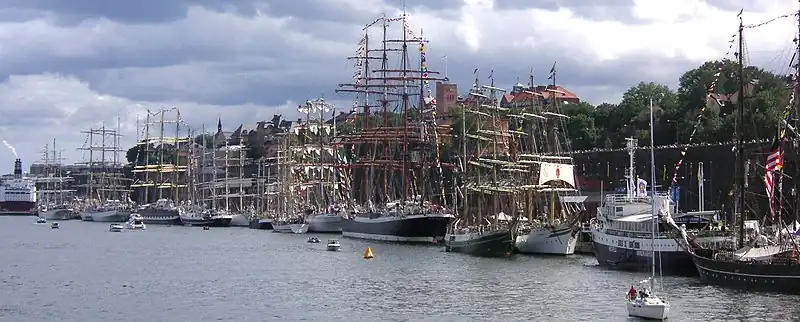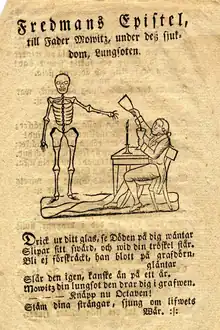Kära syster
Kära Syster (Dear Sister) is No. 24 in the Swedish poet and performer Carl Michael Bellman's 1790 song collection, Fredman's Epistles. The epistle is subtitled "Till kära mor på Bruna Dörren" ("To dear mother at The Brown Door [Tavern]"); its themes are drinking and death. One of his best-known works, it is set to a tune extensively modified from one by Egidio Duni for Louis Anseaume's 1766 song-play La Clochette. Bellman's biographer, Carina Burman, calls it a central epistle.
| "Kära Syster" | |
|---|---|
| Art song by Bellman, music reworked from Egidio Duni | |
 First page of sheet music, 1810 reprint | |
| English | Dear Sister |
| Written | May 1770 |
| Text | poem by Carl Michael Bellman |
| Language | Swedish |
| Published | 1790 in Fredman's Epistles |
| Scoring | voice and cittern |
This was the sixth epistle to be written, and the first not to be continuously cheerful. The narrator, Fredman, encounters the ferryman of the underworld, Charon, and the theme of death is repeated with the ticking of the watch that measures out Fredman the watchmaker's life. Fredman's world, here as in many later epistles, has two sides: one is drunkenness, dance, and love; the other is angst, hangovers, and a longing for death. Kära Syster has accordingly been called a central epistle. The borrowed melody has been adapted with as much work as creating a new one, implying to scholars that Bellman intended a humorous contrast between the familiar melody and the epistle's sombre theme.
Context
Carl Michael Bellman is a central figure in the Swedish ballad tradition and a powerful influence in Swedish music, known for his 1790 Fredman's Epistles and his 1791 Fredman's Songs.[1] A solo entertainer, he played the cittern, accompanying himself as he performed his songs at the royal court.[2][3][4]
Jean Fredman (1712 or 1713–1767) was a real watchmaker of Bellman's Stockholm. The fictional Fredman, alive after 1767, but without employment, is the supposed narrator in Bellman's epistles and songs.[5] The epistles, written and performed in different styles, from drinking songs and laments to pastorales, paint a complex picture of the life of the city during the 18th century. A frequent theme is the demimonde, with Fredman's cheerfully drunk Order of Bacchus,[6] a loose company of ragged men who favour strong drink and prostitutes. At the same time as depicting this realist side of life, Bellman creates a rococo picture, full of classical allusion, following the French post-Baroque poets. The women, including the beautiful Ulla Winblad, are "nymphs", while Neptune's festive troop of followers and sea-creatures sport in Stockholm's waters.[7] The juxtaposition of elegant and low life is humorous, sometimes burlesque, but always graceful and sympathetic.[2][8] The songs are "most ingeniously" set to their music, which is nearly always borrowed and skilfully adapted.[9]
Song
Music and verse form
The epistle was written between March and May 1770.[10] There are 3 stanzas, each of twenty lines; the third line is repeated when sung. The rhyming scheme is AAB-BCC-DDDD-AAE-EFF-GHGH. Its time signature is 4
4, with its tempo marked Andante.[11][12]
The melody has been attributed to a duet, "A la fête du Village", from Egidio Duni's music for Louis Anseaume's 1766 song-play La Clochette, but the musicologist James Massengale states that while that timbre is not "incorrect", the epistle cannot be sung to that tune.[13] Massengale analyses the elaborate changes that Bellman made to the Anseaume-Duni melody, including splitting the music for Colinette's part of the song and placing it at the start and end of the epistle, certainly in his view a conscious reworking. He says that the changes must have cost "an enormous amount of labor ... not to mention the musical talent that was necessary to bring about such change successfully".[14] He notes that Bellman could well have seen the French production of La Clochette at Bollhuset which ran from 1767 to 1769, so there is no need to propose a Swedish variant of the melody for Bellman to have heard.[14]
Lyrics

1 Haga park (S. 64) – 2 Brunnsviken – 3 Första Torpet (Ep. 80) – 4 Kungsholmen – 5 Hessingen (Ep. 48) – 6 Lake Mälaren (Ep. 48) – 7 Södermalm – 8 Urvädersgränd – 9 Lokatten tavern (Ep. 11, Ep. 59, Ep. 77), Bruna Dörren tavern (Ep. 24, Ep. 38) – 10 Gamla stan (Ep. 5, Ep. 9, Ep. 23, Ep. 28, Ep. 79) – 11 Skeppsbron Quay (Ep. 33) – 12 Årsta Castle – 13 Djurgården Park – (Ep. 25, Ep. 51, Ep. 82) – 14 Gröna Lund (Ep. 12, Ep. 62) – 15 Bellman's birthplace – 16 Fiskartorpet (Ep. 71) – 17 Lilla Sjötullen (Bellmanmuseet) (Ep. 48) – 18 Bensvarvars tavern (Ep. 40) 19 Rostock tavern (Ep. 45)
The epistle is set in the Bruna Dörren tavern, which stood on Stockholm's Stadsgården wharf to the southeast of Gamla stan, the old town. The drunkard Fredman confronts his imminent death.
| Carl Michael Bellman, 1790[1] | Eva Toller's prose[15] |
|---|---|
Kära syster! |
Dear sister, |
Reception

The Bellman scholar Lars Lönnroth writes that this was the sixth epistle to be written, but that unlike the earlier five, the mood is not continuously cheerful, and Fredman does not appear as a letter-writing apostle: instead, he plays the role of a desperate confessor in front of a housewife at the tavern. Although he claims to be dressed as a "hero of Bacchus", he feels rejected and afraid of his own shadow.[16] In the song, the ferryman Charon appears for the first time, ready to carry Fredman to the realm of the dead. The theme of death is repeated in the watch that measures his time, at the same time as it is connected to his previous work as a watchmaker and symbolizes his beating heart. Bellman soon put Charon in a text about the Order of Bacchus, which became Fredman's song No. 5.[17]

The scholar of Swedish literature, Carina Burman, writes in her biography of Bellman that Fredman's world has two sides: one is drunkenness, dance, and love; the other is angst, hangovers, and a longing for death. She calls Kära syster "a central epistle", stating that in 1770, Bellman must have been driven by his idea of Fredman, and wrote like a man possessed. The epistle, she writes, sees Fredman speculating about the world after his death, when he has been "embalmed by Bacchus", but even as a dead man he cannot imagine leaving his tavern, asking that when his ghost returns to the Bruna Dörren, the barmaids are not to be mean with his drink. She notes the paradoxes in all this: the real Fredman had already died, but was still flourishing in Bellman's imagined present-day Stockholm; while at the end of the epistle, the fictionalised Fredman is dying, but is begging for a drink (of brandy) so that he won't die of thirst.[18] She notes that in epistle 79, "Charon i Luren tutar", written 1785, Fredman again hears Charon calling, and there he says his farewell to the barmaids of another pub, Maja Myra's tavern on Solgränd off Stortorget in Stockholm's Gamla stan; "with one foot in Charon's boat, Fredman drains his last glass" – but it is not brandy but ale, and it runs down his clothes: before death, he is baptised in the almost magical fluid.[19]
The musicologist James Massengale writes that although the melody was borrowed, the amount of work that Bellman had to put into the music for this epistle, as for no. 12 ("Gråt Fader Berg och spela") was "surely tantamount to the production of new melodies." Borrowing was accepted, even encouraged at the time, but the "poetic possibility", Massengale suggests, is that Bellman wished to exploit the humorous contrast between a melody of one type and a story of another, or between an existing image associated with the melody, and a fresh one presented in an epistle. In addition, Bellman was able to use what his audience knew to be borrowed music to reinforce the historical flavour of the epistles, introducing exactly the kind of ambiguity that he was seeking.[20]
The song has been recorded by Bellman interpreter Fred Åkerström on his 1969 album Fred sjunger Bellman, by the Dutch interpreter of Bellman Cornelis Vreeswijk on his 1971 studio album Spring mot Ulla, spring! Cornelis sjunger Bellman, and by the actor Mikael Samuelsson on his 1988 album Carl Michael Bellman.[21]
References
- Bellman 1790.
- "Carl Michael Bellmans liv och verk. En minibiografi (The Life and Works of Carl Michael Bellman. A Short Biography)" (in Swedish). Bellman Society. Archived from the original on 10 August 2015. Retrieved 25 April 2015.
- "Bellman in Mariefred". The Royal Palaces [of Sweden]. Archived from the original on 21 June 2022. Retrieved 19 September 2022.
- Johnson, Anna (1989). "Stockholm in the Gustavian Era". In Zaslaw, Neal (ed.). The Classical Era: from the 1740s to the end of the 18th century. Macmillan. pp. 327–349. ISBN 978-0131369207.
- Britten Austin 1967, pp. 60–61.
- Britten Austin 1967, p. 39.
- Britten Austin 1967, pp. 81–83, 108.
- Britten Austin 1967, pp. 71–72 "In a tissue of dramatic antitheses—furious realism and graceful elegance, details of low-life and mythological embellishments, emotional immediacy and ironic detachment, humour and melancholy—the poet presents what might be called a fragmentary chronicle of the seedy fringe of Stockholm life in the 'sixties.".
- Britten Austin 1967, p. 63.
- "Epistel N:o 24". Bellman.net. Retrieved 9 December 2021.
- Bellman 1790
- Hassler & Dahl 1989, pp. 52–55.
- Massengale 1979, pp. 166–168.
- Massengale 1979, pp. 74–77.
- Toller, Eva (2009). "Till kära mor på Bruna Dörren – Epistel Nr 24" (PDF). Eva Toller (translator). Retrieved 12 December 2021.
- Lönnroth 2005, pp. 163–164.
- Lönnroth 2005, pp. 164–165.
- Burman 2019, pp. 167, 169.
- Burman 2019, pp. 466–468.
- Massengale 1979, pp. 78–79.
- Hassler & Dahl 1989, pp. 276–285.
Sources
- Bellman, Carl Michael (1790). Fredmans epistlar. Stockholm: By Royal Privilege.
- Britten Austin, Paul (1967). The Life and Songs of Carl Michael Bellman: Genius of the Swedish Rococo. New York: Allhem, Malmö American-Scandinavian Foundation. ISBN 978-3-932759-00-0.
- Burman, Carina (2019). Bellman. Biografin [Bellman: The Biography] (in Swedish). Stockholm: Albert Bonniers Förlag. ISBN 978-9100141790.
- Hassler, Göran; Dahl, Peter (illus.) (1989). Bellman – en antologi [Bellman – an anthology]. En bok för alla. ISBN 91-7448-742-6. (contains the most popular epistles and songs, in Swedish, with sheet music)
- Kleveland, Åse; Ehrén, Svenolov (illus.) (1984). Fredmans epistlar & sånger [The songs and epistles of Fredman]. Stockholm: Informationsförlaget. ISBN 91-7736-059-1. (with facsimiles of sheet music from first editions in 1790, 1791)
- Lönnroth, Lars (2005). Ljuva karneval! : om Carl Michael Bellmans diktning [Lovely Carnival! : about Carl Michael Bellman's Verse]. Stockholm: Albert Bonniers Förlag. ISBN 978-91-0-057245-7. OCLC 61881374.
- Massengale, James Rhea (1979). The Musical-Poetic Method of Carl Michael Bellman. Stockholm: Almqvist & Wiksell International. ISBN 91-554-0849-4.
External links
- Text of epistle 24 at Bellman.net
